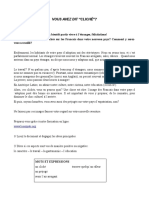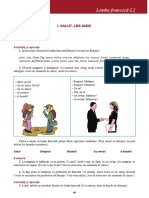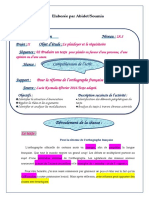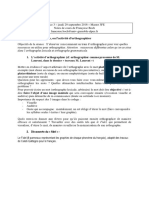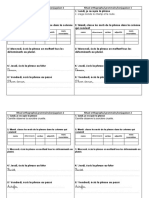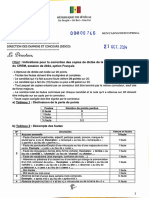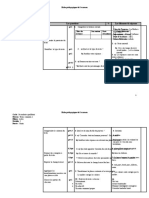HOW TO WRITE A DIALOGUE
HOW TO WRITE A DIALOGUE
Transféré par
7qxnk7yvgmDroits d'auteur :
Formats disponibles
HOW TO WRITE A DIALOGUE
HOW TO WRITE A DIALOGUE
Transféré par
7qxnk7yvgmCopyright
Formats disponibles
Partager ce document
Partager ou intégrer le document
Avez-vous trouvé ce document utile ?
Ce contenu est-il inapproprié ?
Droits d'auteur :
Formats disponibles
HOW TO WRITE A DIALOGUE
HOW TO WRITE A DIALOGUE
Transféré par
7qxnk7yvgmDroits d'auteur :
Formats disponibles
HOW TO WRITE A DIALOGUE
I.OBSERVATION:
a. Le dialogue écrit doit renseigner le lecteur sur les faits et gestes, opinions et
sentiments des personnages.
-Il est nécessaire d’ajouté des verbes pour introduire les paroles, ils apportent des
indications sur le ton utilisé, les expressions faciales ou les gestes.
b. Il doit donner l’illusion d’entendre une langue orale.
- Des indices permettent de savoir quel est le registre de langue utilisé comme les
formes contractées. Ex : he’s, i’ll. Mais aussi les réponse courtes ou les interruptions.
c. Il doit respecter une certaine forme.
La forme du dialogue anglais diffère de celle du dialogue français.
-le dialogue anglais n’utilise pas les mêmes guillemets : English=… ; Français= « … »
-il n’y a pas de tiret.
-il n’y a pas d’inversion du sujet et du verbe introducteur : anglais= she said ; francais=
dit-elle.
-on vas à la ligne lorsqu’il y a un changement de locuteur.
-et seuls les propos des locuteurs sont entre guillemets.
II.APPLICATION :
1.Présenter le lieu, le moment de la scène et les personnages (athlète, journaliste).
2.Respecter la ponctuation (guillemets) et allez à la ligne pour chaque changement de
locuteur.
3. variez les verbes introducteur et étoffez vos phrases avec des adverbes :
Les verbes :
speak Speak loudly Speak to express feelings
Agree, admit, answer, deny, Cry, shout, yell, scream. Complain, insist, sob,
explain, reply. threaten, groan, weep.
Body language
Grin (sourire), nod (faire un signe de tête), wave hello or goodbye (agiter la main…), wince
(grimace)
Les adverbes :
Depending on your mood, you can say something:
Angrily, anxiously, gratefully, proudly, sadly, sincerely, curiously, quietly, furiously.
Final task
You and your partner will play a journalist and a commonwealth athlete who is being
interviewed.
You will:
1. Present the athlete and his/ her sport.
2. Talk about the relations between England and the Commonwealth country you
have been given.
3. Think of ways to improve these relationships.
-Use the information on the relations between commonwealth countries and England you
found for the map.
-Make sure to use the preterit simple.
Final task
You and your partner will play a journalist and a commonwealth athlete who is being
interviewed.
You will:
1. Present the athlete and his/ her sport.
2. Talk about the relations between England and the Commonwealth country you
have been given.
3. Think of ways to improve these relationships.
-Use the information on the relations between commonwealth countries and England you
found for the map.
-Make sure to use the preterit simple.
Final task
You and your partner will play a journalist and a commonwealth athlete who is being
interviewed.
You will:
1. Present the athlete and his/ her sport.
2. Talk about the relations between England and the Commonwealth country you
have been given.
3. Think of ways to improve these relationships.
-Use the information on the relations between commonwealth countries and England you
found for the map.
-Make sure to use the preterit simple.
Vous aimerez peut-être aussi
- FR Débutant - PPT (Pour FR 1) (4) - Latest - Edited - VersionPas encore d'évaluationFR Débutant - PPT (Pour FR 1) (4) - Latest - Edited - Version60 pages
- Document 05 Les Fonctions Du LangagePas encore d'évaluationDocument 05 Les Fonctions Du Langage6 pages
- Les - Differents - Registres - de - Langage À ImprimerPas encore d'évaluationLes - Differents - Registres - de - Langage À Imprimer7 pages
- Field - Media - Document 3286 Languesloupe Voyage CompletPas encore d'évaluationField - Media - Document 3286 Languesloupe Voyage Complet5 pages
- Fiche de Déroulement de La CE Prof Interview100% (1)Fiche de Déroulement de La CE Prof Interview5 pages
- 33-FR a List of Expressions for Everyday CommunicationPas encore d'évaluation33-FR a List of Expressions for Everyday Communication12 pages
- 10ème CLASSE ANGLAIS - LIRE UNE ENTRÉE DE DICTIONNAIRE.pdfPas encore d'évaluation10ème CLASSE ANGLAIS - LIRE UNE ENTRÉE DE DICTIONNAIRE.pdf12 pages
- 612bbd6f8e07dcours-de-grammaire-la-communication-les-registres-Pas encore d'évaluation612bbd6f8e07dcours-de-grammaire-la-communication-les-registres-5 pages
- Vente Les Differents Registres de LangagePas encore d'évaluationVente Les Differents Registres de Langage5 pages
- 4FR31DVWB0023D07 DevoirFrancais-U07Pas encore d'évaluation4FR31DVWB0023D07 DevoirFrancais-U075 pages
- Grammaire - Adjectifs Possessifs: LecturePas encore d'évaluationGrammaire - Adjectifs Possessifs: Lecture7 pages
- Vocabulaire Synonymes Antonymes Paronymes HomonymesPas encore d'évaluationVocabulaire Synonymes Antonymes Paronymes Homonymes5 pages
- Pour La Réforme de L'orthographe Française. Mme AbidetPas encore d'évaluationPour La Réforme de L'orthographe Française. Mme Abidet5 pages
- Thème: Les Métiers.: Evaluation DiagnostiquePas encore d'évaluationThème: Les Métiers.: Evaluation Diagnostique7 pages
- 3 ème séance - troubles de langage[1]Pas encore d'évaluation3 ème séance - troubles de langage[1]6 pages
- Séance 3 Notes Relatifs Orthographe FidelPas encore d'évaluationSéance 3 Notes Relatifs Orthographe Fidel6 pages
- LES CODES ORAL ET ECRIT - Docx Les Registes de LanguesPas encore d'évaluationLES CODES ORAL ET ECRIT - Docx Les Registes de Langues7 pages
- Valentin Vydrine Pronoms Personnels GourPas encore d'évaluationValentin Vydrine Pronoms Personnels Gour26 pages
- Emmener Ou Amener, Apporter Ou Emporter - Parlez-Vous FrenchPas encore d'évaluationEmmener Ou Amener, Apporter Ou Emporter - Parlez-Vous French7 pages
- PR Sentation Langage 6 9 Ans Et Mat RielPas encore d'évaluationPR Sentation Langage 6 9 Ans Et Mat Riel1 page
- Les Secrets Pour Bien Conjuguer Au PrésentPas encore d'évaluationLes Secrets Pour Bien Conjuguer Au Présent10 pages
- 01 - Verbes Du Troisième Groupe - Exercices (A)Pas encore d'évaluation01 - Verbes Du Troisième Groupe - Exercices (A)2 pages
- Crem 2024 Indications Correction DictéePas encore d'évaluationCrem 2024 Indications Correction Dictée2 pages



















